University of Edinburgh team prepare for autonomous race car competition
Posted on May 18, 2021 in News
We recently caught up with Edinburgh University Formula Student (EUFS) team, to see how they are progressing in developing their first autonomous electric-powered race car ready for the much anticipated 2021 Formula Student competition.
Over Zoom we talked with Artificial Intelligence (AI) Team Manager Rokas Giedraitis, AI Perception Manager Keane Quigley and AI Perception team member Angus Stanton, to understand how Covid restrictions have affected this year’s project. In particular development of the autonomous car, and how preparations for the competition are advancing.
Live 2021 event at Silverstone
The Formula Student organisers (IMechE) have just announced their plans to run the 2021 competition live at Silverstone from 21st to 25th July, following the Formula 1 British Grand Prix. In 2020 the impact of the Covid pandemic meant the competition was moved online and only the Static events took place. This included the engineering design presentation, cost and sustainability and business presentations. An extra Static event aimed at evaluating team simulation environments also occurred. In 2021 the Dynamic events including the autonomous sprint and skidpad are scheduled to continue at Silverstone.
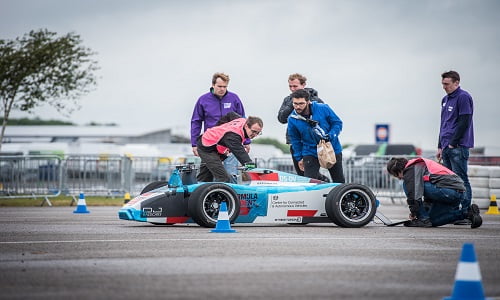
The team at Silverstone in 2019
Rokas explained, “Even though both the manned internal combustion engine competition and the autonomous car competition are planned to take place at Silverstone in the summer, there is a huge amount of work we need to finish before either car will be allowed to compete.”
Mapix supports winning EUFS team
Mapix technologies have supported the Edinburgh University Formula Student (EUFS) team as Platinum Sponsors for the past four years, providing both Velodyne LiDAR equipment and mentoring. During this time we have seen a huge growth in the size of the team and incremental leaps forward each year in the team’s knowledge and experience. The EUFS team won the AI Formula Student competition three times during this period in 2018, 2019 and 2020.
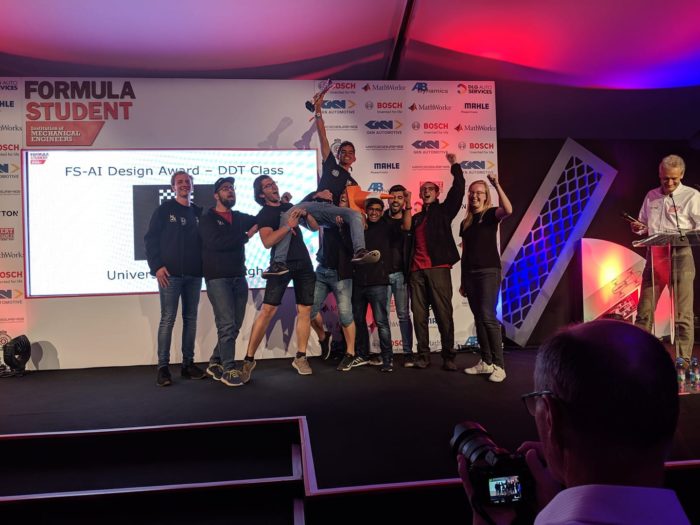
The winning EUFS team in 2019
EUFS’s first electrically powered autonomous race car
Rokas and his team are focused on the AI autonomous part of the competition. In past years the organisers have provided one autonomous vehicle and each team mounts their own hardware onto this car in turn to complete a number of dynamic challenges. This year will be the first where the Edinburgh University team will also be racing their own fully designed electrically powered autonomous car. The chassis has been commandeered from the team’s manned combustion engine vehicle that was entered in the 2019 competition. They have worked incredibly hard to source and build all the other components required, including the electric powertrain. Mapix technologies provide the autonomous team with a Velodyne Puck (VLP-16) LiDAR scanner, which is mounted in a safe location on the top of the car.
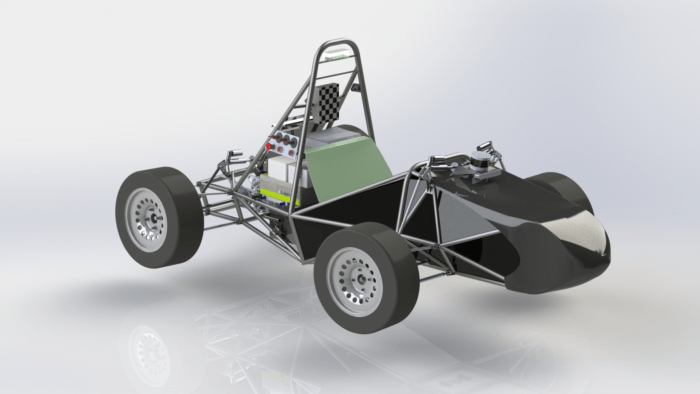
EUFS electrically powered autonomous car (left) and manned internal combustion powered car (right) for the 2021 competition..
It’s a long journey to Silverstone
To qualify to race their new autonomous car numerous criteria need to be completed. Before the competition at Silverstone, the team have to submit documents to prove they have a working autonomous vehicle, to be allowed to enter the physical competition.
Rokas commented, “This year due to the Covid safety protocols the team also has to submit all the Static event submissions before the physical event. These are taking place before the live event this year to allow more time for the Dynamic events, which may take longer due to social distancing and Covid restrictions at the race circuit. For the Static challenges, we are currently preparing a number of presentations on our design, vehicle status and also business reports.”
The team have to prove they have a working vehicle long before it is taken on a trailer to Silverstone. Once at the live event they will also have to pass a strict six stage scrutinising test. Safety being a key issue with a car driving itself around circuits, the team has to prove their ability to stop the vehicle in an emergency.
There are over 100 students involved in the development of the two Edinburgh University cars spanning Engineering, Computer Science, Physics and Mathematics departments.
Limitations for the team
Rokas explained, “Recruitment for the 2021 team started at the end of the last academic year. Through the University’s social media we were able to build the team. We have not been able to meet as a team throughout the whole year, so far. We did experience a slightly higher drop out rate this year than previous, but despite the limitations, we have done very well.”
Focus on the design stage
The restrictions have meant the team had longer to spend on the design stage of the autonomous car, carefully considering all the elements. Adapting well to working together via Microsoft Teams, Keane said, “It was just not the same as being side by side working with teammates. Our professors and lecturers have been very helpful in assessing and advising on the designs.”
Lack of field trip testing
Keane and Angus had planned to test a LeddarTech LiDAR sensor loaned by Mapix technologies to complement the Velodyne unit for improving the car’s blind spot. Unfortunately, the University had listed this testing as a form of field trip and so it could not go ahead due to Covid restrictions. To substitute this, Keane and Angus did manage to connect the LeddarTech LiDAR unit to a video camera to act as a motion sensor in their student flat. The aim is to monitor and track one of their flatmates who sleepwalks. Angus added, “We did capture some funny videos, but we dared not wake him.”
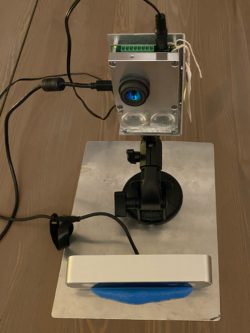
The LeddarTech LiDAR test unit used to monitor sleepwalking in the student flat
The team plans to work further on motion distortion correction when restrictions ease after 17th May enabling them to gather more real world data. In the competition last year they noticed the pitching motion of the car caused the LiDAR sensor to miss cones further away when the car was traveling faster than 8m/s. The team may use the electric wheelchair that Mapix technologies donated as a testbed if they can get the team to run fast enough pushing it.
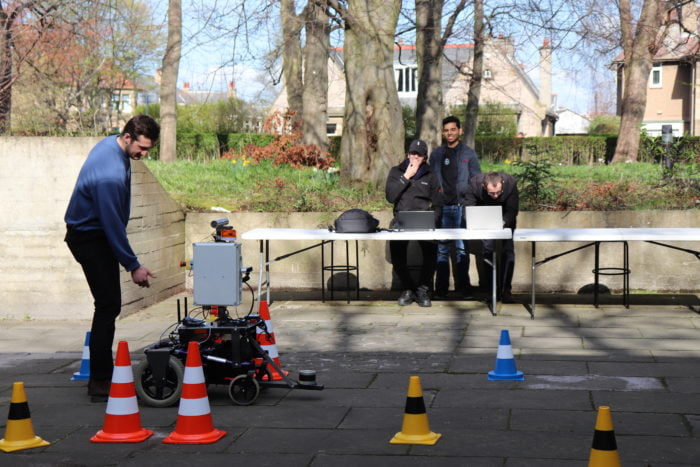
‘William’ the electric wheelchair Mapix technologies donated to EUFS as a testbed
Scan accumulation improvements
This year the team has been working on scan accumulation working with data from previous year’s competitions and testing. Keane mentioned, “We’re able to accumulate multiple scans (10-15) which then leads to having more points per cone in the distance. We can therefore extract more cones than without accumulation which enables us to know more of the track sooner.”
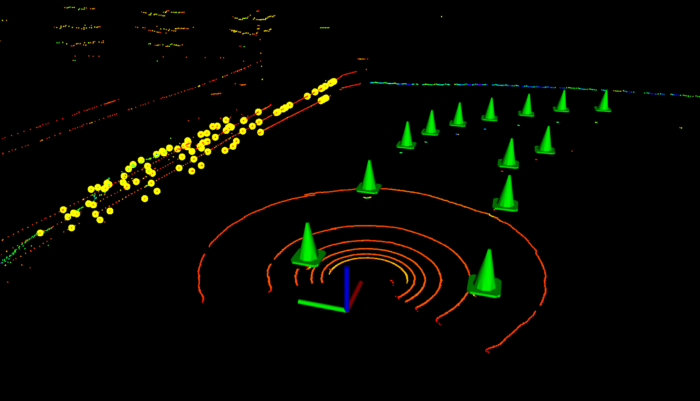
Moving to ROS2
One of the more difficult parts of the project this year has been converting the autonomous operating system from ROS1 to ROS2. Rokas mentioned, “We did not expect this would be so difficult or lengthy. Much of the software stack had to be re-written. However, we will not have to change the setup now for a number of years. We are looking forward to fully testing this with the autonomous platform.”
Progressing to manufacturing
The most difficult part of the project this year has been manufacturing. Due to the Covid restrictions, the team has not been allowed to access their laboratories in the School of Engineering to physically work on the cars. These restrictions are due to be lifted in Scotland on 17th May. They cannot wait for this date to arrive so they can focus on manufacturing and testing.
During this phase, all the work undertaken across the various teams, from the Hardware Integration, Powertrain, Electronics, Perception, Localisation & Mapping, Planning & Control, and Software Infrastructure teams, comes together. They admit the testing stage will probably not be extensive as in previous years. Keane mentioned, “There is the added difficulty that when open we will not have full time access to the labs. With the additional safety aspects of working with an electric powertrain, we do have specific requirements and limitations with our working spaces.”
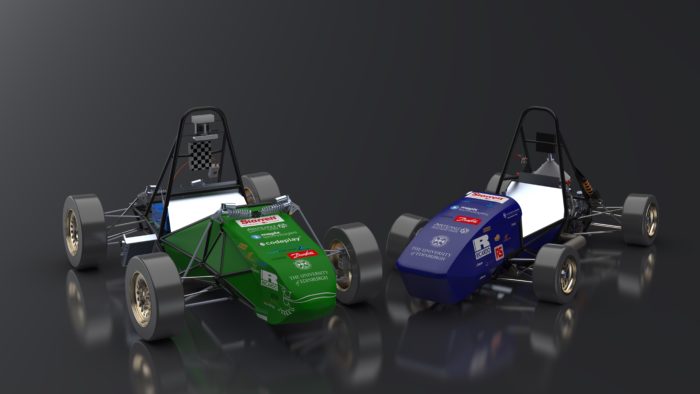
The autonomous (left) and combustion engine (right) EUFS cars
So the team is on a big push now completing both their academic course exams and preparing the Formula Student presentations. Once the labs open they will commence physically working on the car.
Beyond the syllabus
Rokas commented, “For future years we would like Edinburgh University to create a Formula Student module with the Department of Informatics. This will allow students to gain 20 credits towards their courses. At present all the work carried out on the Formula Student project is extra-curricular and does not count towards their degree courses.”
The live autonomous events
The Dynamic autonomous events the team will compete in include a straight line drag race, autonomous navigation of a circuit lined with cones and a figure of 8 circuit. Once the car has “learned” the circuit from its first lap it will be required to drive a further 9 laps as fast as possible. The figure of 8 circuit is one of the most complicated events, the autonomous car has to complete two left-hand circuits, then transfer for two right-hand circuits before leaving on a different exit point to where it entered. This is tricky as the car needs to “know” which lap it is on and when to switch to the other loop.

Gus added, ”We are seeing more competitors from other universities entering the autonomous parts of the competition. This year we are expecting tough competition from Modena University in Italy, assuming they are able to travel, and Bath University have also entered in the ADS class.”
Fantastic experience
The long-term career benefits of working on the Formula Student project go far beyond adding the experience to your CV. Formula Student has seen over 20 years of competitions with The University of Edinburgh team entering for the past five years. Rokas mentioned, “The project provides a huge amount of hands-on experience and helps improve technical skills. Learning how to manage your own workload and communicate with other team members is vital. Other transferable skills gained include business planning, project management, budgeting and presentation skills. Formula Student provides opportunities to become sub-team managers and then team managers as you progress through the years.”
Best of luck
The team at Mapix technologies wish the team at The University of Edinburgh every success with the 2021 Formula Student competition. We will be following their progress at Silverstone with interest and look forward to sharing great stories from the event.
For more information see the article on Learnings of LiDAR by the EUFS team
